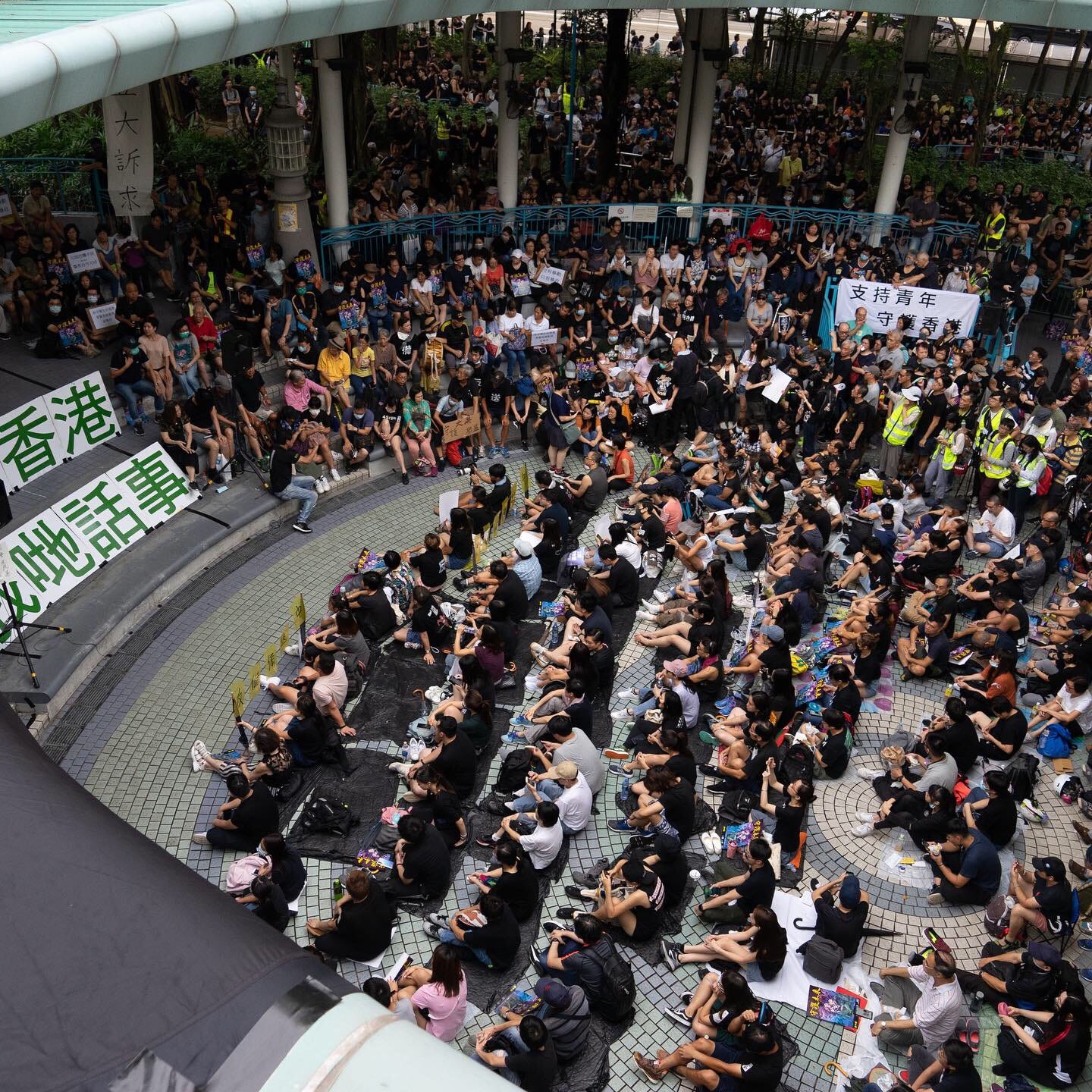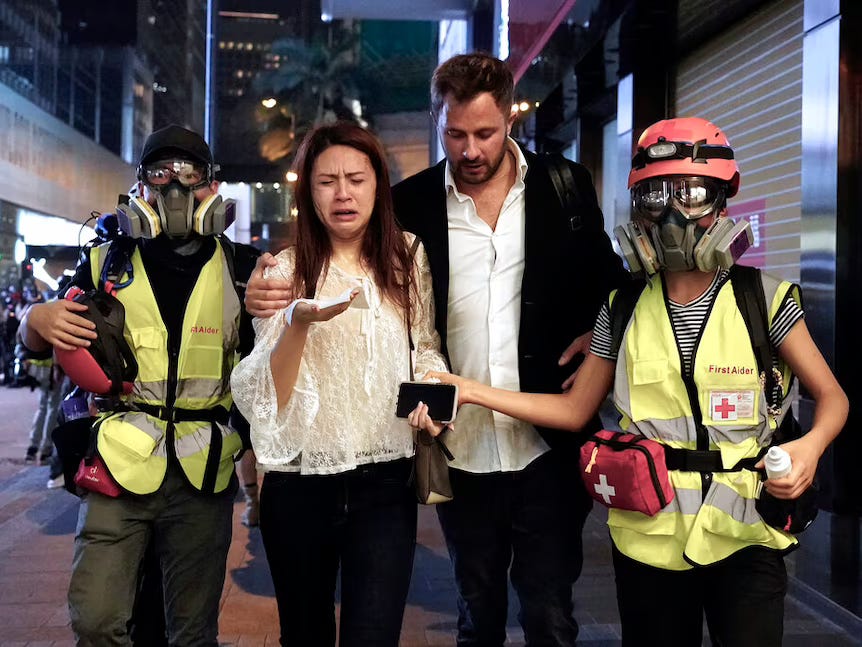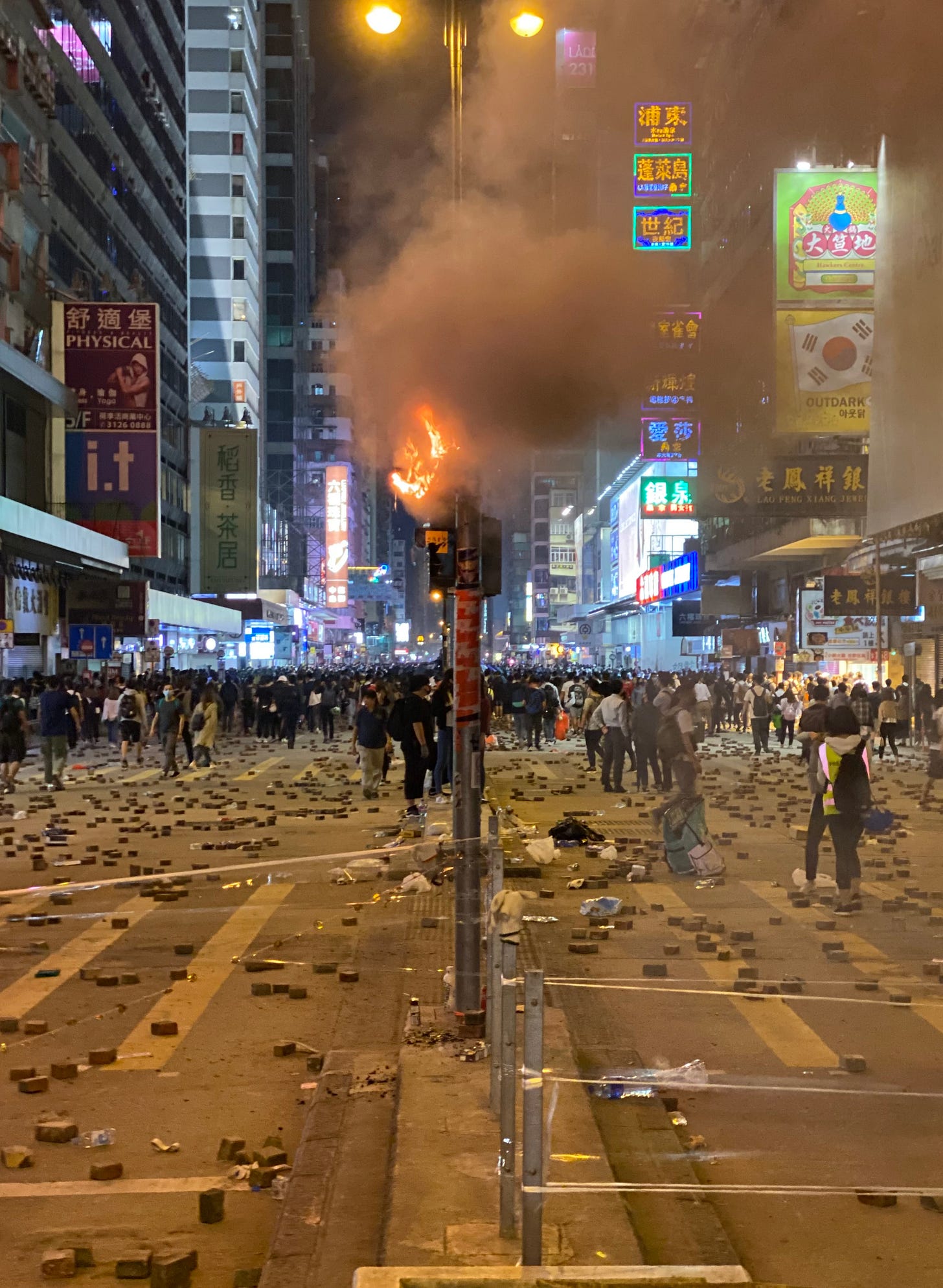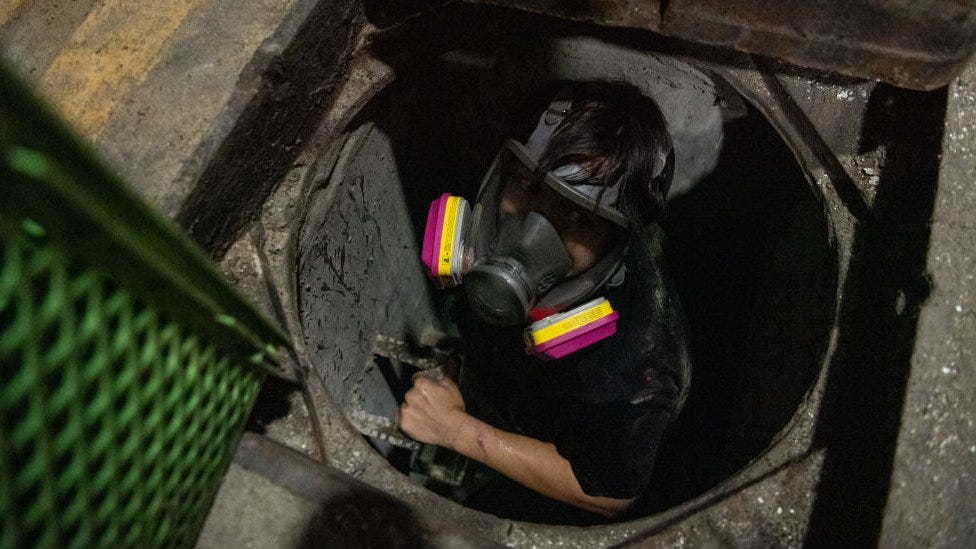Charged with one crime, convicted of another: how one baffling rioting conviction exposes Hong Kong's broken courts
With the number of dissidents unjustly imprisoned on rioting charges growing, Alvin Cheng's unjust treatment underscores the alarming lengths some Hong Kong judges will go to secure convictions.
These articles take a lot of time to prepare, and are only possible thanks to support from readers. Will you support this Substack with a US$8/month or $80/year donor subscription? Your donation sustains my efforts to expose abuses in the Hong Kong courts. Thank you for your support!
Earlier this year, in a courtroom twist that defied reason, well-known Hong Kong localist activist Alvin Cheng Kam-mun began his trial facing charges of ‘perverting the course of justice’ and ended it with a nearly four year sentence for rioting—a crime with which he had not been charged, nor received a trial.
As Cheng and his co-defendants entered the courtroom of District Court Judge Cheng Lim-Chi, only a few spectators filled the gallery. Their alleged crimes, carrying the prospect of just a few months in prison, had garnered far less attention than the hundreds of defendants charged with rioting or national security crimes, crimes that carry the weight of severe, years-long sentences.
Yet by the end of the 13-day trial, Alvin[1] would be handed just such a sentence for rioting, one of the most serious—and common—charges doled out to those involved in the 2019 pro-democracy protests.
Despite scant evidence of any violence on the part of many defendants, Hong Kong’s judges have managed to manipulate law and evidence to secure a guilty verdict. This is often achieved by mischaracterizing clothing associated with the political movement and protective gear as evidence of rioting. Judge Cheng’s conviction of Alvin, however, is a particularly stark example of the extraordinary measures some judges have been willing to employ to imprison dissidents for “riots” they never actually participated in.
A failed rescue
In November 2019, a campus protest turned into a standoff when police laid siege to Hong Kong Polytechnic University. From November 17-29, hundreds of people were trapped inside the university’s buildings, surrounded by unyielding police lines. Initial attempts to break through these lines, both from some of those trapped inside and thousands supporting them from outside, met with little success. By November 19, the siege had descended into a tense waiting game.
Enter Alvin Cheng and his co-defendants. As alleged in court, they arrived on the scene on November 20, their mission daring and difficult: to help those trapped inside escape through the sewer system connected to the university. Millions in the city had watched for days as the police continued their relentless siege against the protesters, many of whom had taken no part in the violence of the first two days. In response to this crisis, some, like Alvin and his team, allegedly took it upon themselves to orchestrate a rescue.
Their plan, however, was thwarted. Police, having intercepted two of the defendants and placed them under arrest, searched their phones and discovered the rescue plan. The police then scoped out several of the would-be rescuers near the sewer entrance, where they were waiting with their cars. Eventually, Alvin and another person emerged from the sewer, only to be promptly surrounded by police. Alvin's companion managed to evade arrest, but Alvin and the rest were not so fortunate.
With the alleged riot already over, the defendants couldn’t be charged with aiding and abetting a riot directly. Instead, they found themselves indicted on the lesser charge of ‘perverting the course of justice’. Of the initial group, three chose to plead guilty. The remaining five, including Alvin, finally stood trial three years later in late 2022.
A trial turned on its head
The case was assigned to Judge Cheng Lim-Chi. A national security judge handpicked by the government, Cheng is perhaps best known for imprisoning two courtroom spectators for sedition, one a pastor, for clapping in court and declaring that a magistrate had “lost [her] conscience.” As in most cases involving high profile dissidents, his assignment to Alvin Cheng's case—which did not necessitate a national security judge—was likely far from random.
The prosecution was led by Memi Ng, a private barrister who has built her career taking on political prosecution contracts for the DOJ. Some readers may recognize Ng’s name: Among other political cases, she was the prosecutor in my own political trial and prosecuted well-known activists Joshua Wong, Agnes Chow, and Ivan Lam for inciting an unlawful assembly.
As the perverting justice trial began, Ng presented the DOJ’s case with few surprises for the defense. Police surveillance had tracked the defendants to their cars near the sewer entrance, and Alvin was seen emerging from the sewer.
However, the prosecution's case against Alvin was marred by a significant flaw: a complete absence of evidence linking him to the sewer escape attempt. Neither witness testimony, nor video footage, nor admissions from the other defendants described the group arriving at the sewer. Police first spotted the group when they were already on scene, and they first saw Alvin when he emerged from the sewer just before his arrest. While the defendants were accused of 'perverting justice' by attempting to rescue protesters, and it was assumed Alvin was with them, none of the available evidence directly identified Alvin as one of these alleged rescuers.
On the 11th day of trial, after the prosecution had rested its case, Alvin’s lawyer applied to dismiss the charge, citing the absence of any evidence to support it. This is a common procedure in trials: once the prosecution has laid out their case, the defense can request the dismissal of charges before they present their own evidence. If the defense can show that the prosecution hasn’t offered evidence to support each element of the offense—as was indeed the case here—the judge will dismiss the charges.
After hearing the legal arguments, Judge Cheng conceded that the evidence against Alvin was indeed inadequate. Yet, instead of adhering to procedure and dismissing the charges, he ventured into unprecedented territory: he offered the prosecutor the opportunity to introduce additional charges against Alvin.
While Judge Cheng's written Reasons For Verdict suggested that the idea of modifying the charge originated with Prosecutor Ng, eyewitness accounts contradicted this claim. A spectator I spoke to recalled that after conceding that he could not convict Alvin of 'perverting justice', Judge Cheng invited the prosecutor to propose an 'alternative charge'. When Ng seemed unprepared for this, Judge Cheng suggested adjourning the court to give the DOJ time to reconsider.
Following the adjournment, Prosecutor Ng asked to add a charge of rioting to the indictment, a far more severe charge that would necessitate an entirely different factual basis. Despite vehement objections from the defense, Judge Cheng agreed to the change. As a result, Alvin was convicted of rioting and sentenced to three years and eight months in prison (reduced from four-and-a-half years due to the “delay” in the charge being made).
This stark departure from established procedure was a clear breach of the right to a fair trial, as guaranteed by Article 87 of Hong Kong’s Basic Law. The defense had spent 11 days cross-examining witnesses and building their strategy around the original charge. Allowing the prosecution to alter the charge after the defense had committed to this course of action was undeniably unfair.
The Far Reach of Rioting: A Tool for Suppressing Dissent
Alvin’s case is a particularly egregious abuse of process amongst the hundreds of cases in which rioting charges have been used as a means to lock up political opponents for years.
Much has been written on Hong Kong’s 2020 National Security Law, which along with the British-era sedition law has been used to imprison government critics ranging from pro-democracy politicians and media executives to students and homemakers, while casting a net of fear over the city.
But while there’s no doubt the NSL has been used to drastically curtail Hongkongers’ civil liberties, NSL cases make up only a small fraction of political prosecutions in the city. Of the more than 1,500 (and counting) imprisoned activists and dissidents, about nine out of ten were imprisoned under other laws, most for protest-related offenses. Of these laws, rioting stands out for its particularly long sentences—a maximum of ten years, or seven years if tried without a jury in District Court (where the DOJ has uniformly brought these cases).

As of June 2023, according to The Witness, 438 people have been convicted of rioting, with 151 pleading guilty and 287 convicted after trial. Only 66 have been acquitted. 156 defendants are still awaiting trial, four years after the protests. Most of these defendants have been tried together with as many as a dozen people, where their individual circumstances and behavior are given little attention.
Nearly half of those convicted have been sentenced to over four years in prison, with 37 sentenced to more than five years and only seven to less than two years.
These numbers would be tragic in any circumstances, but what’s most disturbing about these cases is that most defendants have been convicted on little to no evidence that they actually rioted.
Under the rioting law, a conviction requires the prosecution to prove the defendant personally “participated” in the riot. But many judges, from the Court of Final Appeal down to dozens of District Court judges, have shown a willingness to stretch the definition of “participation” well beyond reason.
In about a third of rioting cases, according to The Witness’ statistics, the prosecution was able to show defendants’ direct participation in rioting activities like blocking roads or throwing objects. But in the rest, with no such evidence available, judges have had to get creative. Most commonly, they have found defendants “participated” in a riot via highly circumstantial evidence, such as wearing black clothing, displaying protest slogans, or possessing gear like gas masks, goggles and helmets.
The Court of Final Appeal explicitly endorsed this approach in November 2021. In a decision on two rioting cases, the CFA ruled that a vast range of tenuous circumstantial evidence could be used to obtain a conviction. Citing a two-century-old British case, the CFA wrote:
“It does not take a great deal of activity on the defendant’s part to move the case from the ‘mere presence’ to the ‘encouragement’ category. Thus, in 1810, Mansfield CJ stated in Clifford v Brandon: ‘The law is, that if any person encourages or promotes, or takes part in riots, whether by words, signs, or gestures, or by wearing the badge or ensign of the rioters, he is himself to be considered a rioter, and he is liable to be arrested for a breach of the peace.’”
Beyond relying on a two-century old case—highly unusual in itself—there are clear problems with using a defendant’s clothing to find them guilty of rioting. During the 2019 protest period, black clothing, often imprinted with pro-democracy slogans, was ubiquitous as a way to show support for the movement. Office workers wore black t-shirts to work; children wore them to school. And virtually everyone who attended peaceful protests wore them as well. On June 16, 2019, for example, an estimated two million people marched peacefully for democracy, autonomy, and police accountability—the vast majority wearing black clothing and displaying items with protest slogans.

As for gas masks, goggles and helmets, these were also far more common amongst ordinary Hongkongers than one might think. Most protests were organized on short notice and would be held at points all over the city. Police became notorious for indiscriminately shooting tear gas and rubber bullets at gatherings with little warning, without regard for the many bystanders going about their day on Hong Kong’s crowded streets. As more and more reports and images appeared of uninvolved pedestrians being gassed, hit with rubber bullets, and otherwise injured, there was a rush to purchase protective gear. Peaceful protesters would bring these to demonstrations to protect them in case the police started shooting, with no intention to participate in any riots themselves.
Even outside of protests, many would cart protective gear with them throughout their day in case they encountered a police attack—an increasingly likely occurrence as the months wore on. I carried my gas mask to work and back, to restaurants in the evening, and any other time I needed to go out of my neighborhood. I was far from the only one.

Since the CFA’s endorsement of basing convictions on such flimsy evidence, Hong Kong’s judges have become increasingly bold in convicting defendants of rioting on the most tenuous basis: their “attire and gear,” their “all black clothing,” that they had “chanted and showed support to the protesters,” or that they were carrying “a laser pointer,” for example. In ruling after ruling, judges have shown that the high burden of proof previously required to convict someone of a crime holds little weight in post-2019 Hong Kong.
Judge Cheng’s dishonest verdict
But Alvin’s case, perhaps more than any other, shows just how far some judges are willing to go to obtain these convictions. Despite no evidence that Alvin had been anywhere near the scene until days after the alleged riot ended, Judge Cheng altered the charge against him to convict him of rioting, denying him the right to a trial on the charge in the process.
In his Reasons for Verdict, Judge Cheng attempted to justify his decision to convict Alvin of a serious crime for which he had not been tried. He cited a section of the Criminal Procedures Ordinance, Cap 221 Section 23, which states:
“Where, before trial or at any stage of a trial, it appears to the court that the indictment is defective, the court shall make such order for the amendment of the indictment as the court thinks necessary to meet the circumstances of the case unless, having regard to the merits of the case, the required amendments cannot be made without injustice.”
While the term “defective” isn’t defined in the Criminal Procedures Ordinance, its legal meaning is well-established. A defect refers to a technical error with the indictment, such as a misspelling, an incorrectly used term, or an outdated statute number. It does not pertain to a sweeping change in the legal foundation of the case—especially not after the trial has nearly concluded.
To support his extraordinary decision, Judge Cheng referenced only one previous case—HKSAR v Lui Tsun Sum, a 2021 case from the Court of Appeal. But either Judge Cheng didn’t actually read that case, or he was hoping no one else would, because it directly contradicts his ruling.
In Lui Tsun Sum, a panel of three judges on the Court of Appeal overturned a trial verdict where the charges against the defendants—alleged members of an organized crime triad society—were changed from “conspiracy to extort” to “acting in the capacity of a triad society member” after all evidence had been presented. The judges rejected the change as unfair to the defendants. Writing for the court, judge Derek Pang wrote:
“No matter what tactics the defence would have adopted back then [at the beginning of trial], or whether they could mount some new defence at the retrial is beside the point. The injustice of the present case is: the applicants would have been acquitted if there had not been any amendments. After the amendments, the prosecution had all the evidence to prove the case and the applicants would be convicted for sure.”
To support its decision, the Lui Tsun Sum court cited several British cases in which a defect in the indictment was allowed to be amended, and briefly summarized the reasons why:
“the amendment was nothing else but only technical; the amendment concerned only a matter of form and not of substance and it did not end up with a substitution of a different offence; and the amendment deprived the defence only of a technical and unmeritorious argument.”
In all these cases, the Court of Appeal noted, the defects were technical, not substantive changes.
The law could not have been more explicit. Judge Cheng's blatant disregard for the Lui Tsun Sum ruling and suspicious failure to cite other cases in his Reasons for Verdict—an essential practice when tackling complex legal points—demonstrates that he was fully aware of his departure from established law. And in doing so, Judge Cheng violated Alvin's right to a fair trial.
***
Judge Cheng’s violation of Alvin's rights was an especially egregious abuse of judicial power. Yet, abuses of court process in rioting cases have become less the exception and more the norm. Hardly a week passes without a new rioting conviction anchored in suspect circumstances—be it through the criminalization of pro-democracy clothing, blatant discrepancies in evidence descriptions, or the advent of "creative" legal interpretations as was so starkly demonstrated in Alvin Cheng's case.
There remains a queue of rioting cases, a pipeline of potential injustices, slowly winding their way through the system. Yet, internationally, these cases rarely make it to the forefront of public consciousness. The spotlight tends to gravitate towards the National Security Law and its specially appointed judges, overshadowing the exploitation of common law courts for political purposes.
It's important to recognize the reality of what's transpiring: Beijing's erosion of rule of law is not limited to the National Security Law—it has permeated the very heart of Hong Kong's common law system. Therefore, the international community should not only respond to the overt abuses of the National Security Law but also shine a light on the subtler yet equally devastating injustices unfolding within common law courts.
[1] In order to avoid confusion, I’ve referred throughout this article to Alvin Cheng as “Alvin” and Cheng Lim-Chi as “Judge Cheng.”








An outrageous act of lawlessness - by a judge!